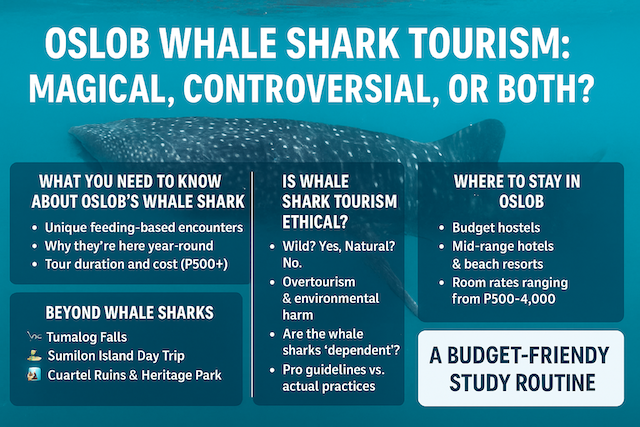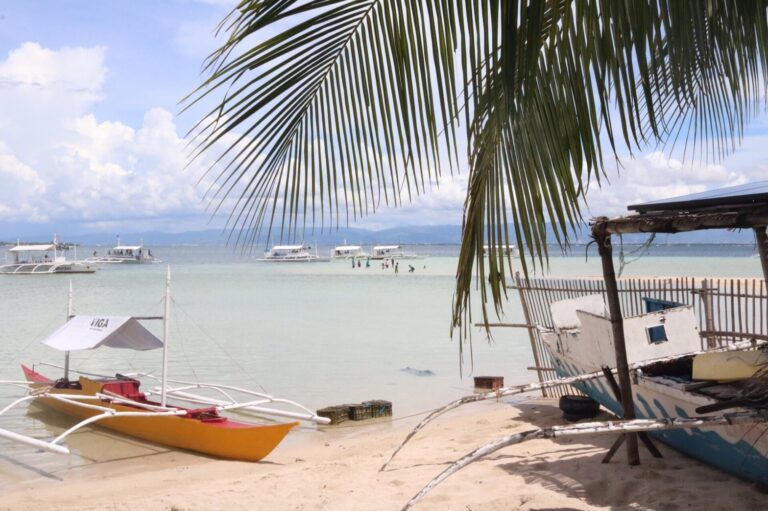Oslob Whale Shark Tourism: Magical, Controversial, or Both?
Contents
- 1 Oslob Whale Shark Tourism: Magical, Controversial, or Both?
- 2 🗺️ 1. Where Is Oslob — and Why Is It So Famous?
- 3 🐋 2. What to Expect from the Whale Shark Experience
- 4 🚐 3. How to Get to Oslob from Cebu City
- 5 🌊 4. Ethical Tourism: Is It Really Safe for the Whale Sharks?
- 6 🎒 5. Trip Essentials: What to Bring, What It Costs, and How to Make the Most of It
- 7 🛏️ Where to Stay in Oslob: Top 5 Hotels for Every Budget
- 8 🏝️ 6. What Else to Do in Oslob (Beyond the Whale Sharks)
- 9 🌊 Tumalog Falls: A Misty, Magical Escape Just Minutes from the Sea
- 10 🏖️ Sumilon Island Day Trip: Crystal Waters and Calm Luxury Just Off the Coast
- 11 🏛️ Cuartel Ruins & Heritage Park: A Glimpse into Oslob’s Colonial Past
- 12 🧭 7. Final Thoughts: Is Oslob Worth It? Magical, Controversial… or Both?
Oslob Whale Shark Tourism: Magical, Controversial, or Both?
A Deep Dive into One of the Philippines’ Most Talked-About Attractions
You’ve seen the photos.
A massive whale shark gliding through the turquoise waters of the Philippines, just inches away from excited snorkelers.
It looks unreal — and for many, swimming with these gentle giants in Oslob is a “bucket list” dream.
But beneath the surface (literally and figuratively), there’s more to this experience than stunning Instagram shots.
Over the past decade, Oslob has become one of the Philippines’ most famous — and most debated — tourist destinations.
Located on the southern tip of Cebu Island, this once-sleepy fishing village is now known worldwide for one thing: guaranteed close encounters with whale sharks.
Unlike other destinations where sightings depend on luck and timing, Oslob offers near-daily access to whale sharks, thanks to a local feeding program that attracts them close to shore.
That convenience has drawn thousands of visitors — but it has also sparked controversy.
Conservationists question the long-term impact on the animals.
Travelers argue over the ethics of artificial feeding.
And first-time visitors often find themselves asking:
“Should I go? And if I do… will I regret it?”
That’s where this guide comes in.
In this article, we’ll break down everything you need to know before visiting Oslob — including:
-
What the whale shark experience is actually like
-
How to get there (and what it costs)
-
The growing ethical debate surrounding the tours
-
Tips for making your trip more responsible
-
And what else you can do in Oslob if you choose not to swim
Whether you’re planning your first trip to the Philippines, or still on the fence about whether this experience is right for you, this guide will help you make an informed, respectful, and unforgettable decision.
Let’s dive in.
🗺️ 1. Where Is Oslob — and Why Is It So Famous?
Oslob is a small coastal town located on the southeastern tip of Cebu Island, about 120 kilometers (75 miles) from Cebu City. While it was once a quiet fishing village, it has transformed over the last decade into a major stop on the Philippines’ adventure tourism circuit.
The main reason?
Whale sharks — the world’s largest fish.
These gentle giants, known locally as butanding, can grow up to 12 meters long and weigh more than 20 tons. In Oslob, they’re commonly seen just a few hundred meters offshore, where a group of local fishermen-turned-tourism-staff feed them small shrimp early each morning.
This feeding practice has made Oslob famous for its reliability:
-
In other countries, seeing a whale shark requires a lot of luck.
-
In Oslob, sightings are almost guaranteed year-round.
That convenience has made it one of the most accessible and popular whale shark experiences in the world, attracting travelers from all over Asia, Europe, and beyond.
Aside from the whale sharks, Oslob is also known for:
-
🏞️ Tumalog Falls – a stunning curtain-like waterfall nearby
-
🏝️ Sumilon Island – a private island with clear blue waters and white sandbars
-
🏰 Heritage sites – such as the old Spanish-era church and Cuartel ruins
For many travelers, a day trip to Oslob includes whale shark watching in the morning, a stop at Tumalog Falls, and an island-hopping extension to Sumilon in the afternoon.
Whether you’re a marine life enthusiast or just looking for a once-in-a-lifetime photo opportunity, Oslob offers a unique — and unforgettable — mix of nature and adventure.
🐋 2. What to Expect from the Whale Shark Experience
If you’ve never seen a whale shark up close before, prepare yourself: they are enormous. But in Oslob, this awe-inspiring encounter is both surprisingly structured and surprisingly brief.
Here’s what the experience typically looks like — step by step:
📅 Arrive Early (Very Early)
Most tours (and even DIY trips) require you to arrive between 5:30–7:00 AM.
The whale shark interactions only happen in the morning, when local fishermen scatter food in the water.
By 10:00 AM, the activity usually shuts down.
💡 Tip: If you’re coming from Cebu City, this means leaving around 3:00 AM by car or joining an organized tour with hotel pickup.
📝 Orientation and Briefing
Before getting in the water, all visitors attend a mandatory orientation session, which covers:
-
Basic rules (no touching, no sunscreen, no flash photography)
-
Safety instructions
-
Environmental reminders
🚫 Touching or getting too close to the sharks can lead to fines — and harm the animals.
🚣 Boat Ride + 30-Minute Swim
You’ll be assigned to a small paddle boat (with about 6–8 people) and taken just a few hundred meters offshore.
There, you’ll have 30 minutes in the water to swim, snorkel, or simply observe the whale sharks.
You can:
-
Snorkel on the surface (gear is provided)
-
Stay on the boat and watch
-
Bring a GoPro or waterproof camera (no flash)
The whale sharks tend to move slowly and stay near the surface, making it relatively easy to see and photograph them.
⏱️ It’s Fast — But Intense
Don’t expect a full day in the water.
The entire experience — from arrival to exit — usually lasts around 1.5 to 2 hours.
But that short time can leave a deep impression.
Some travelers call it “life-changing.”
Others say it felt rushed or too controlled.
It really depends on your expectations.
🚐 3. How to Get to Oslob from Cebu City
DIY vs Tour: What’s the Best Way?
Oslob is located about 120 km south of Cebu City, and getting there isn’t complicated — but it does require an early start and a bit of planning.
Here are your main options:
Option 1: 🚐 Join an Organized Tour (Most Popular)
This is by far the most convenient and time-efficient choice for first-time travelers.
Most tours include:
-
Hotel pickup at 3:00–4:00 AM (Cebu City or Mactan)
-
Private van transportation (round-trip)
-
Whale shark interaction fee
-
Snorkeling gear rental
-
Optional side trips to Tumalog Falls and Sumilon Island
💰 Typical Price: ₱2,000–₱3,500 per person ($35–$60), depending on inclusions
Pros:
-
No need to worry about bus schedules
-
Arrive early enough to avoid crowds
-
Can sleep in the van
Cons:
-
Less flexibility
-
Might feel rushed if combined with multiple stops
Option 2: 🚌 Do It Yourself (Budget-Friendly)
If you’re adventurous (or on a tight budget), you can get to Oslob on your own.
Step-by-step:
-
Take a bus from Cebu South Bus Terminal
→ Look for a Ceres bus heading to Bato via Oslob
→ Buses leave every 30–60 minutes, 24/7
→ Travel time: 3.5–4 hours -
Tell the driver to drop you at the whale shark center
-
Pay your entrance fee and join the orientation
💰 Estimated Cost: ₱300–₱500 total one-way ($6–$10), depending on transportation and gear rental
Pros:
-
More flexible
-
Cheapest option
-
Ideal if you want to stay overnight in Oslob
Cons:
-
Very early wake-up
-
No hotel pickup
-
You may miss prime swimming times if you arrive late
Option 3: 🚖 Hire a Private Driver
If you’re traveling in a small group (2–4 people), this can be a cost-effective and comfortable middle ground.
💰 Estimated Cost: ₱4,000–₱6,000 for the round trip (split between passengers)
Pros:
-
Custom schedule
-
Can combine with other attractions (falls, island hopping)
-
More comfort and privacy
In short:
If you want it easy — go with a tour.
If you want it cheap — take the bus.
If you want it your way — hire a driver.
🌊 4. Ethical Tourism: Is It Really Safe for the Whale Sharks?
Not everything about swimming with whale sharks in Oslob is picture-perfect.
While many travelers describe the experience as magical, marine biologists and conservationists have raised serious concerns about the long-term impact on the animals — and the ocean ecosystem as a whole.
So, what’s the problem?
🐟 The Feeding Controversy
In Oslob, whale sharks are drawn close to shore by daily hand-feeding — typically small shrimp (uyap) tossed into the water by local fishermen.
This guarantees sightings, but it also alters the animals’ natural behavior:
-
Whale sharks are migratory by nature — but in Oslob, some have become semi-resident.
-
Instead of feeding at depth, they now rely on surface-level handouts.
-
They often approach boats expecting food, which increases the risk of boat strikes.
Multiple studies have shown changes in feeding patterns, migration habits, and even scarring from human interaction.
🤝 The Economic Reality
At the same time, it’s important to understand the human side of the story.
Oslob’s whale shark tourism has created hundreds of jobs and brought income to an area that previously relied on fishing alone.
Many locals — including boatmen, gear handlers, and tour guides — now earn a steady income and are more motivated to protect the sharks than exploit them.
In this sense, Oslob has become a real-world example of “conservation through tourism” — albeit a complicated one.
⚖️ So… Is It Ethical?
It depends who you ask.
-
🐋 Conservation groups like WWF and Marine Wildlife Watch have voiced concerns
-
🧳 Some travelers boycott Oslob and choose places like Donsol, where feeding is not allowed
-
🌴 Others believe the experience raises awareness and funds protection
There is no universal answer — only informed choice.
What matters is that you understand both sides before deciding whether to go.
✅ If You Do Choose to Go…
There are ways to make your experience more responsible:
-
Follow all rules — no touching, no sunscreen, no flash
-
Stay calm and avoid splashing or chasing
-
Don’t try to “get the perfect selfie”
-
Book through operators who prioritize education and conservation
-
Consider donating to local marine protection initiatives
Oslob’s story is complex — part success, part cautionary tale.
Your visit can be part of the problem, or part of the solution, depending on how you approach it.
🎒 5. Trip Essentials: What to Bring, What It Costs, and How to Make the Most of It
You’ve decided to go — or at least you’re leaning toward it.
Here’s everything you need to prepare, pack, and budget for a smooth and responsible Oslob experience.
💰 Entrance Fees and Costs (2025 Updated)
| Item | Price (₱) | Notes |
|---|---|---|
| Whale shark snorkeling (local visitor) | ~₱600 | Includes gear, orientation, 30 mins |
| Whale shark snorkeling (foreigner) | ~₱1,000 | Higher rate for non-residents |
| Watch from boat (no swimming) | ~₱500 | Recommended for non-swimmers |
| Underwater camera rental | ~₱500–₱700 | Optional, limited availability |
| Locker rental | ~₱100 | To keep valuables dry |
| Tumalog Falls entrance | ₱50 | Often added after the swim |
| Sumilon Island tour (optional) | ₱1,500–₱2,000 | Boat ride + entrance fee |
💡 Some all-inclusive tours may offer discounted packages that bundle most of these costs.
🎒 What to Pack
-
🩱 Swimsuit (already worn under your clothes)
-
🧥 Rash guard or quick-dry shirt
-
🩴 Waterproof sandals
-
🧢 Hat and sunglasses (for before/after the swim)
-
🧼 Towel and change of clothes
-
📱 Waterproof pouch or dry bag
-
🪪 Government-issued ID (some sites require it)
⚠️ Do NOT wear sunscreen before entering the water — it’s banned to protect marine life.
📅 Sample Schedule (From Cebu City)
| Time | Activity |
|---|---|
| 3:00 AM | Depart Cebu City (via van or private car) |
| 6:00 AM | Arrive in Oslob / orientation |
| 6:30 AM | Whale shark interaction |
| 7:30 AM | Breakfast at local eatery |
| 8:30 AM | Visit Tumalog Falls (optional) |
| 10:00 AM | Depart for Sumilon Island or head back to Cebu |
| 1:30 PM | Arrive back in Cebu City (approx.) |
🧠 Pro Tips
-
Bring cash — most vendors don’t accept cards
-
If prone to motion sickness, take meds before the drive
-
Avoid weekends and holidays to escape crowds
-
Eat light before swimming (but don’t go hungry)
-
Charge your phone and camera the night before
🛏️ Where to Stay in Oslob: Top 5 Hotels for Every Budget
Whether you’re planning a quick overnight stay or a relaxing weekend escape, Oslob offers a range of accommodations to suit your travel style and budget.
Here are our top 5 picks — based on location, value, and traveler reviews:
1. Casa Bonita Inn – Budget Traveler’s Favorite
💰 ₱800–₱1,200/night
Located just minutes from the whale shark interaction site, this guesthouse offers clean rooms, friendly staff, and a super convenient location.
-
Great for solo travelers or backpackers
-
Air-conditioned private rooms
-
Walking distance to eateries and convenience stores
✅ Ideal if you’re arriving late or leaving early the next day
2. Luna Oslob Travellers Inn – Most Popular with Students
💰 ₱1,000–₱1,500/night
Simple, comfortable, and affordable — this place is loved by long-term travelers and groups of friends.
-
Spacious rooms for groups or pairs
-
Can help arrange tours and transport
-
Near both the Cuartel ruins and whale shark area
✅ Good balance of price and comfort
3. Gingging Hotel & Resort – Mid-Range with a Pool
💰 ₱2,000–₱2,800/night
This hotel offers a bit more luxury with a pool, restaurant, and ocean views — but still at a reasonable price.
-
Relaxing after a long day of touring
-
Family-friendly and well-reviewed
-
Breakfast included
✅ Perfect for couples or weekend escapes
4. Down South 118 Beach Resort – Beachfront and Beautiful
💰 ₱2,500–₱3,500/night
If you want to wake up to the sound of waves, this is your spot. Clean, quiet, and stylish without being too pricey.
-
On-site dining and beachfront hammocks
-
Sunset views directly from your room
-
Great for digital nomads or couples
✅ One of Oslob’s hidden gems
5. Bluewater Sumilon Island Resort – Luxury Experience
💰 ₱6,000–₱12,000/night
For those wanting the full resort experience, Sumilon Island’s only resort offers private villas, infinity pools, and top-tier service.
-
Ideal for honeymoons or high-end travelers
-
Private access to sandbar and marine sanctuary
-
Round-trip boat service included
✅ Best if you want peace, privacy, and paradise
💡 Tip: Book at least 2–3 weeks in advance during peak season (Dec–May). Most hotels offer free cancellation via Booking.com or Agoda.
🏝️ 6. What Else to Do in Oslob (Beyond the Whale Sharks)
Oslob might be famous for its whale sharks — but there’s more to this seaside town than just 30 minutes in the water.
If you’ve come all this way, it’s worth exploring the area a bit more before heading back to Cebu City.
Here are the best add-ons to make your Oslob trip a full-day adventure:
🌊 Tumalog Falls: A Misty, Magical Escape Just Minutes from the Sea
After your adrenaline-filled encounter with the whale sharks, Tumalog Falls offers the perfect counterbalance — calm, cool, and quiet.
Located just a short drive from the Oslob whale shark center, this beautiful waterfall is often included in day tours, and for good reason.
📍 Where Is It and How Do You Get There?
Tumalog Falls is situated about 10–15 minutes uphill from the whale shark briefing area.
While the road is paved, the final stretch is too steep for most tour vans — so you’ll typically transfer to a local motorbike (habal-habal) for the last 5 minutes.
💰 Expect to pay ₱50–₱100 round-trip for the bike ride.
🕒 The falls are open from 6:00 AM to 5:00 PM, with the best light and fewest people early in the morning.
🌿 What Makes Tumalog Falls Special?
Unlike powerful, roaring waterfalls that crash down in thunderous sprays, Tumalog is delicate and dreamlike.
The water trickles and fans out over moss-covered rocks, forming a curtain of mist that sparkles in the sun. It’s often described as:
-
A “natural shower”
-
A “fairy tale backdrop”
-
Or simply “refreshing beyond words”
The pool at the base is shallow and cold — perfect for dipping your feet or taking a quick swim.
Fish sometimes nibble at your toes, creating a natural spa-like feeling. Just be careful on the slippery rocks.
📸 Instagram Tip: Stand on the outer rocks with the falls in the background for a magical full-body shot — best with wide-angle lens or phone portrait mode.
🧘 Why It’s Worth Your Time
Some travelers skip Tumalog thinking it’s “just another waterfall.” But those who visit often say it was the most peaceful and photogenic part of the whole Oslob trip.
-
It’s uncrowded (especially on weekdays)
-
There’s shade, fresh air, and no entrance pressure
-
It’s a chance to slow down and reconnect with nature after a busy morning
⚠️ Seasonal Note
Tumalog Falls is seasonally affected — during dry months (February–May), the flow can reduce to a gentle trickle.
But during or after rainy season (June–October), it comes alive in full misty glory.
“After the rush of swimming with whale sharks, Tumalog was the perfect way to decompress. Cold, quiet, and completely unexpected.”
— Clara, traveler from France
🏖️ Sumilon Island Day Trip: Crystal Waters and Calm Luxury Just Off the Coast
If you’re already making the long journey down to Oslob, why not add a tropical island escape to your day?
Just a 15- to 20-minute boat ride from the mainland, Sumilon Island offers some of the clearest waters, softest white sand, and most peaceful scenery you’ll find in Cebu.
🏝️ What Is Sumilon Island?
Sumilon is a privately managed island off the coast of Oslob, owned and maintained by Bluewater Resorts.
It’s small — you can walk the perimeter in under an hour — but it’s packed with natural beauty.
Most travelers visit Sumilon for a day trip, which includes access to:
-
🏖️ A changing sandbar that shifts shape with the tides
-
🌊 Snorkeling areas with coral reefs and colorful fish
-
🌴 Coconut trees and hammocks for lazy afternoons
-
🏊♀️ A protected swimming lagoon
-
🍽️ Optional lunch buffet and use of the Bluewater resort facilities
💡 Note: You do not need to stay overnight at the resort to join a day tour.
🚤 How to Get There
Most day tours to Sumilon depart from Bancogon Port, which is just a 5-minute drive from the Oslob whale shark area.
The boat ride to the island is short but scenic — passing limestone cliffs and turquoise waters.
⏱️ Boats depart every 1–2 hours, starting around 8:00 AM.
📍 Reservations are recommended during weekends or peak season.
💰 Cost Breakdown (2025)
| Package | Inclusions | Price (₱) |
|---|---|---|
| Basic Day Use | Boat transfer, island entrance | ₱1,500–₱1,800 |
| Day Use + Buffet Lunch | Includes access to resort amenities | ₱2,000–₱2,500 |
| Overnight Stay | Starts at ₱6,000+/night | Depends on season & room type |
⚠️ Environmental fees and taxes may apply. Ask your tour provider for full breakdowns.
🏄 What to Do on the Island
You don’t need a full itinerary — Sumilon is all about relaxation and light adventure.
-
Go snorkeling along the island’s marine sanctuary
-
Explore the famous sandbar, which appears and disappears with the tide
-
Rent a kayak or paddleboard near the resort beach
-
Take a short hike to the island’s historic lighthouse and cliff viewpoints
-
Lounge with a coconut drink under swaying palm trees
📸 Tip: Visit early in the morning to catch the sandbar at its widest and brightest.
🧘♀️ Why It Complements the Oslob Trip
After an early morning with whale sharks and bumpy roads, Sumilon feels like a reward — quiet, open, and effortlessly beautiful.
You won’t find crowds here.
You’ll hear only waves, birds, and the occasional splash of a fish.
For many, it’s the perfect way to unwind, whether you’re traveling solo, as a couple, or with friends.
“Sumilon was the highlight of my entire Cebu trip. Calm, uncrowded, and absolutely stunning. I didn’t even want to leave.”
— Daniel, traveler from Brazil
🏛️ Cuartel Ruins & Heritage Park: A Glimpse into Oslob’s Colonial Past
Oslob is known for its natural beauty, but there’s history here too — and you don’t have to go far to find it.
Just a few minutes from the whale shark area, you’ll discover the Cuartel Ruins, one of the most photogenic and peaceful heritage sites in southern Cebu.
🧱 What Is the Cuartel?
The Cuartel is a 19th-century Spanish military barracks, built from coral stones during the colonial period.
Interestingly, the structure was never completed — the Spanish left before its construction was finished, and what remains today are hauntingly beautiful walls, arches, and open corridors.
🏗️ The walls are thick, the archways tall, and the atmosphere surprisingly serene.
Standing inside the Cuartel feels like stepping back in time.
Many visitors compare it to old ruins in Latin America or Southern Europe — but with the added bonus of ocean views and palm trees.
⛪ Next Door: Oslob’s Old Church
Right beside the Cuartel, you’ll find the Church of the Immaculate Conception, also made of coral stone and completed in 1830.
It’s still in use today and gives insight into the deep Catholic roots of the local community.
-
The church plaza is often peaceful and well-maintained
-
Local families come here to walk, pray, or relax in the afternoon breeze
-
Sunset behind the ruins and church facade makes for incredible photos
📸 What to Expect
-
No entrance fee — it’s free to visit
-
Usually uncrowded, especially in the afternoon
-
Great place to walk, reflect, and take in Oslob’s slower pace of life
-
Quiet spot to journal or plan your next move
📷 Tip: Come around 4:30 PM for golden hour photos with soft lighting and few tourists.
✨ Why It Matters
The Cuartel ruins are more than just old stones.
They represent a moment in time — the transition from colonial rule to independence, from past to present.
In a trip filled with nature, adrenaline, and oceans, this place gives you a moment of cultural stillness — and a deeper connection to Cebu’s layered history.
🍽️ Local Eateries
After swimming and exploring, you’ll need a bite.
Oslob has a growing number of budget-friendly local restaurants near the main tourism area offering:
-
Fresh grilled seafood
-
Filipino classics like adobo and pancit
-
Cold buko juice or mango shake to cool off
🌱 Vegetarian options are limited — plan ahead if needed.
Whether you stay just a few hours or extend your trip overnight, Oslob has more than enough to fill a day with nature, adventure, and insight into rural Cebuano life.
🧭 7. Final Thoughts: Is Oslob Worth It? Magical, Controversial… or Both?
Like many travel experiences that go viral on social media, Oslob’s whale shark tourism is both unforgettable and complicated.
On one hand, swimming beside a gentle 10-meter giant in clear blue water is something few people ever forget.
It’s emotional. It’s humbling. For many, it’s the highlight of their trip to the Philippines.
On the other hand, there are real concerns about how this experience is managed — from the daily feeding of the sharks to the long-term changes in their behavior.
So… is it worth it?
The answer depends on you.
If you’re someone who values convenience, close-up interaction, and stunning photos — and you’re willing to follow the rules and approach the experience respectfully — Oslob can offer something truly special.
If you’re deeply concerned about animal welfare or want to support only the most sustainable forms of wildlife tourism, you may prefer alternatives like Donsol, where the encounters are more natural and less guaranteed.
Either way, what matters most is that you make your decision consciously and informed.
This isn’t just a tourist attraction — it’s a living, evolving interaction between people, animals, and the environment.
How we choose to participate says as much about us as travelers as it does about the places we visit.
✅ If You Decide to Go…
-
Do your research
-
Follow all safety and environmental guidelines
-
Support local businesses and marine protection groups
-
And most importantly, stay aware of the impact your presence has
✅ If You Decide Not to Go…
That’s okay too.
There are plenty of other ways to experience Cebu’s beauty, from island hopping in Moalboal to hiking in Osmeña Peak — no whale sharks required.
In the end, Oslob is not just about what’s in the water — it’s about what you bring to the experience.
Magical? Absolutely.
Controversial? Certainly.
A decision worth making with care? Always.



![Beyond Chocolate Hills and Tarsiers: Your Complete Guide to Exploring Bohol Island [2025 Edition]](https://studyenglishdirect.com/wp-content/uploads/2025/05/DSCF7150-e1489128665883-768x576.jpg)


